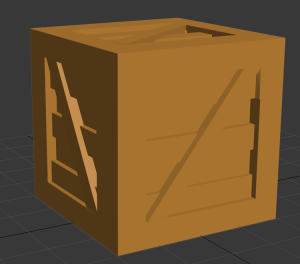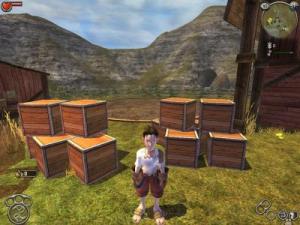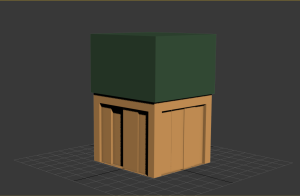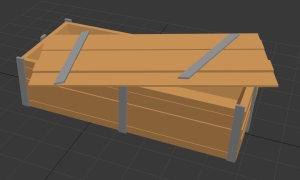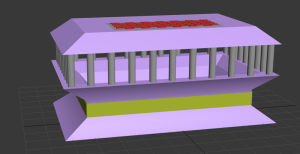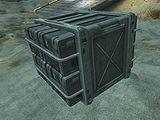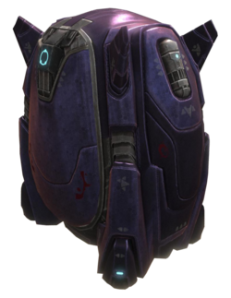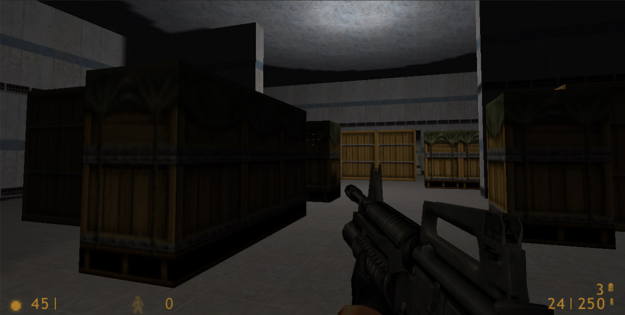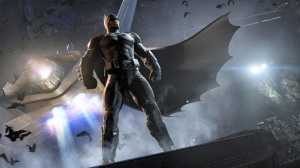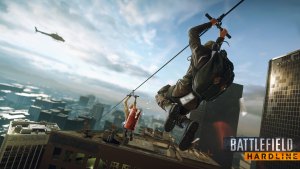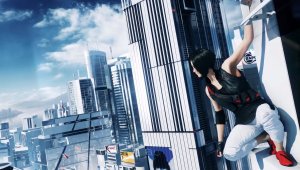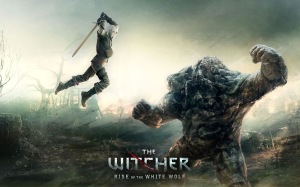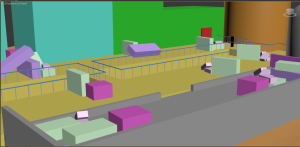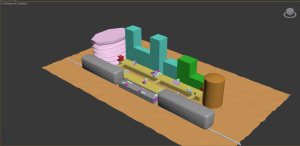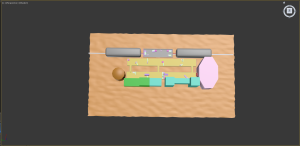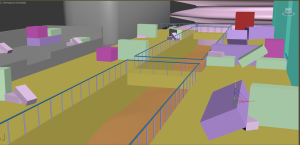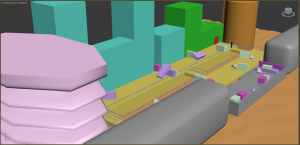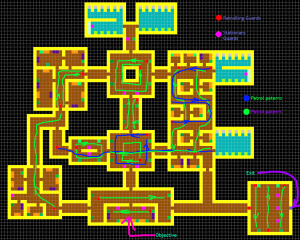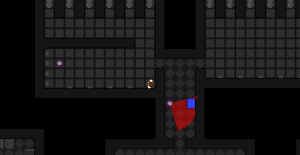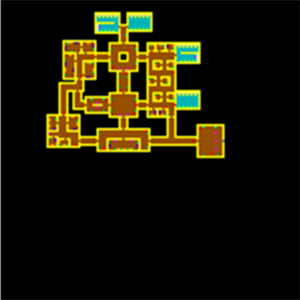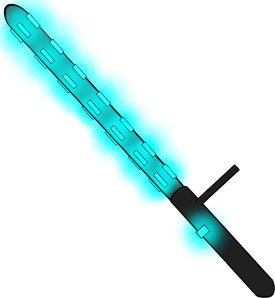When we started this assignment we had an array of board games to choose from, after some brief consideration (since no group member had an extensive knowledge of board games) we decided to just pick one that looked fun, and that game became Smallworld.
Smallworld is a strategy game with small similarities to Risk. The goal of the game is to gather coins and at the end of the game (after 9 turns or so, depending on the amount of players) the player holding the most coins wins the game. The way the player acquire these coins is by holding ”regions” on the board and at the end of the turn you collect coins based on how much land (regions) you control. There are however factors which can increase the amount of coins a region is worth, these come in the shapes of ”Races” and ”Special powers”. For an example, if the player was to be controlling the Dwarfs, they would gain one extra coin for controlling a region with a Mine symbol on it and if they had the special power ”Merchant” they would gain one extra coin for every region under their control. Should the player run out of soldiers to put down on the game board, or simply lose interest in the combination they chose, the player can put the race in ”Decline” allowing them to pick a new race/special power combination.
The picking of races and special powers are to a certain degree random, all in all there are 14 races and 20 special powers, these are randomly put together and at any given time the maximum amount of combinations to choose from is six. The players start with 5 coins each and the first player gets to choose from the first batch of six combinations, these combinations are put up in a row, the first combination in the row does not cost anything, to be able to choose combination number two, you must place one coin on combination number one, to choose combination number 3 the player must put down one coin on the first and second combination etc..
During the first round the players make their initial conquests, starting at the borders of the board, to make a conquest you need to put down two tokens plus 1 token for every enemy token present in the region.
The combinations of races and special powers would be one of the games primary strengths, since every time you play it could look vastly different when looking at what each player could be able to do. The combinations of the races and special powers also give players more reasons to play the game several times, since when you play the game you constantly come up with combinations that you would have liked to see in play.
The special powers and races can also make it very hard to tell which player is in the lead (the value and amount of coins each player possess is hidden) since a player who owns 3 regions can gain similar or even higher amounts of coins every turn than a player who owns 6 regions, depending on what combination of Race/power they control.
The ability to choose new combinations also allows players to easily catch up to each other, so being in the lead in the beginning might not be all that significant.
An example of this would be the first time our group sat down and played the game. After turn one had passed one of the group members had lost all but one of her regions, and the player responsible for conquering those regions was in control of essentially half the board. This naturally drew the attention of the other players who started focusing on stopping the player who appeared to be in the lead. In the end, the player who had sat quietly in his corner of the board, waging practically no wars while holding a relatively small amount of regions, ended up winning the game, being in possession of around 110 coins, with the closest competition ending at 76 coins.
The combinations can at the same time end up being one of the games weaknesses, since it is a strategy game some players might not enjoy the random element of the combinations since they can, at times, end up being insanely powerful. An example of this is the second round we played of the game when one player held more or less half the board for half the game due to the combination he picked. The race he had (sorcerers) enabled him to conquer 4 enemy regions every turn without having to fight, instead he could simply replace 1 enemy token with a new one of his own. This made him very difficult to attack since it was very difficult to attack without leaving at least one weak point in the defense enabling him to quickly reconquer the territory he had lost.
The target audience
The game is recommended for people of age 8 and up, however I do not think this is a correct target audience for the game due to its complexity. I would say that the game would probably do better in a group of players aged 15 and up seeing how there are a lot of rules and different tokens to keep check on.
The game box includes:
* Several different boards that are used depending on how many players there are.
*14 Races and 20 special powers.
*Cheat sheets that briefly explain how the turns are supposed to be played out and explain the different abilities granted by the different races and special powers.
*Plenty of the 4 different types of coins valued 1,3,5 and 10.
*Mountain tokens that represent the extra “defense value” of mountain regions.
*Several “lost tribe tokens” that work like a regular enemy token, except that they are scattered around the board from the start of the game.
*Several different special power tokens that are given to players with the special power that is connected to said tokens.
*1 Turn token that is moved down the turn counter every time all players have finished their turns.
*A more extensive rule book that explains all the rules and special cases (which can appear when specific special powers or races clash).
*Tokens (or units) for every race.
For our group at least, all these rules and powers where hard to keep track on at first, which can make the first round of the game take a long time. To make it easier on the group we skipped reading the rule book and watched a tutorial instead, this tutorial was about 20 minutes long and explained everything we needed to know (more or less) to start playing. After having tried to understand the rules and eventually having played the game a couple of times, my conclusion is therefore that people ranging from 8-12 years old would probably not have that much fun with it.
What I said to be both the strength and weakness of the game is also (according to me) the most interesting system in the game. The way that special powers work together with the races and how those two put together work with the board and other combinations.
To give an example of what makes this so interesting I will put together a few combinations that are incredibly interesting.
Example 1: Decline combo
Race – Ghoul
Special Power – Spirit
The Ghoul ability allows the player to put his/her race in decline while still being able to move, conquer and reinforce them, as if they weren’t in decline.
The Spirit ability allows the player to keep the race it’s combined with to remain in decline without counting towards the maximum of 1 race in decline at a time.
Example 2: War combo
Race – Triton
Special Power – Commando
The Triton ability allows the player to conquer regions bordering to a sea or lake with one less token (although there is always a one token minimum for the conquest).
The Commando ability allows the player to conquer regions with one less token (same restriction as above).
Example 3: Coin combo
Race – Human
Special Power – Merchant
The Human ability grants the player one extra coin for every farmland occupied.
The Merchant ability grants the player one extra coin for every region they control.
Example of a clash between abilities:
The Sorcerers allow one adjacent enemy token to be replaced (and killed) by a sorcerer token. The Elves never lose a token when conquered, and instead always retreat to a nearby friendly region.
When these two abilities clash, the elven region is lost and a sorcerer token is placed, the elven token however is not removed, but instead placed in an adjacent region.
The list of these types of examples could go on for a very long time, in fact, with the races and special powers available without any expansions, there are up to 280 possible combinations of special powers and races. This makes the cheat sheet very handy since it would probably be nigh impossible to keep track on all of these powers and special cases without it.
Looking at the contents of the expansion packs, it is obvious that the creator also knows this to be the most interesting thing about the game since they (if combined) add 13 extra races and 12 extra special powers.
Summary
The core game system revolves around choosing the right Race/Special power combinations, conquering regions on the board and knowing when to go into Decline in order to change combination. At the end of every turn you gain coins (which are the victory condition) depending on how many regions you control. The player with the most coins at the end of the game wins.
The biggest strength of the game is the amount of combinations that are available and how much of a replay value it gives the players. A large portion of what makes these combinations a strength is that they act so differently from each other.
The biggest flaw of the game is that it’s very hard to become “good” at the game, the only thing you can really gain is knowledge of what combinations you need to be afraid of. This results in a (at times) very unstable game where skill is not as important as luck. The entire game can be completely changed because one player happened to get a combination that could be considered “overpowered”. This flaw however, is not always obvious since it’s possible and often likely, that more than one player gets a combination of that caliber. Because of the random element the game is probably better played if you don’t have the expectation that it will be a fair game. The game rules can also seem like a lot to go through and may scare off players at first glance, but once you start to get a hang of the rules of the game it is a lot of fun and slowly becomes easier to understand as you play it through.
The most interesting system in the game is how the race/power combinations can work together on the board and sometimes against other combinations.
Even though we started doubting that Smallworld was the right choice at first, we ended up having a lot of fun with it!
